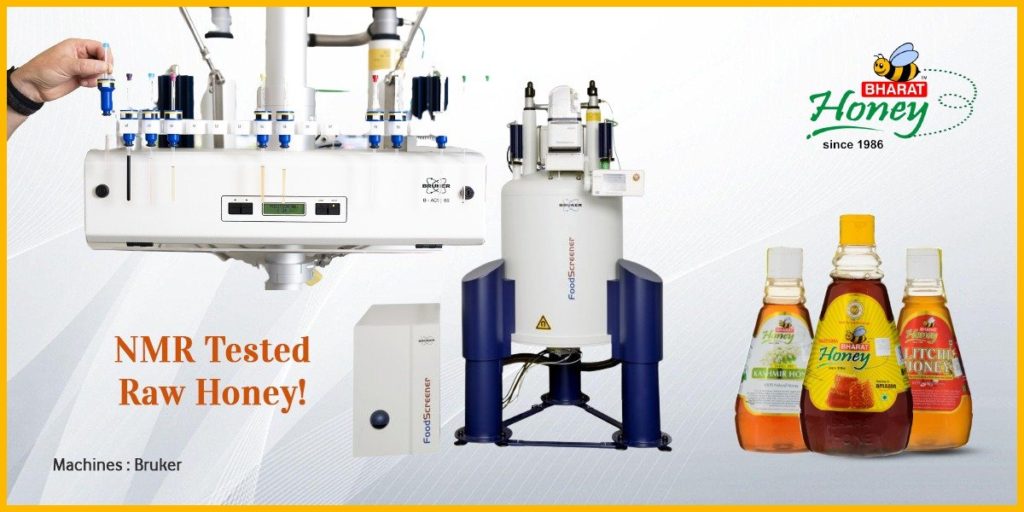What is NMR?
The Nuclear Magnetic Resonance (NMR) test is an advanced procedure, Conducted mainly by Intertek Laboratory in Germany, it can detect adulteration, verify geographical and floral origins, and assess the overall purity of honey.
How is NMR Testing Done?
NMR testing involves placing a honey sample in a strong magnetic field. The atomic nuclei in the sample interact with this field, producing a spectrum that reflects the honey’s chemical composition. This data is then compared to a vast database of known honey profiles to determine the authenticity and purity.
Which Machine is Required and Who Supplies It?
The primary equipment for NMR testing is a high-resolution NMR spectrometer. Bruker, a global leader in analytical instrumentation, supplies the machines used for honey testing. Their equipment is renowned for its accuracy and reliability, making them the go-to supplier for NMR machines worldwide.
Principle Behind NMR Testing
NMR is based on the principle that certain atomic nuclei resonate at specific frequencies when placed in a magnetic field. This resonance depends on the chemical environment surrounding each nucleus, allowing for detailed structural information about compounds present in honey. The unique spectral signatures obtained can differentiate between various types of honey and detect adulterants.
Why Was NMR Designed for Honey Testing?
NMR was designed for honey testing to address the growing issue of honey adulteration. Traditional methods often fail to detect complex adulterants like high-fructose corn syrup and liquid glucose, while NMR offers a comprehensive molecular profile, making it an ideal tool for identifying even the most sophisticated adulteration techniques.
Strengths of NMR Testing
- Comprehensive Detection: NMR can identify a wide range of adulterants, including sugar syrups and synthetic additives.
- Verification of Origin: It can verify both the botanical and geographical origin of honey.
- Non-Destructive: NMR testing is non-invasive, meaning the honey sample remains intact after testing.
Limitations of NMR Testing
- Database Dependency: NMR testing relies on available data for accurate results. If the database does not include specific honey varieties, such as Apis dorsata wild honey in India, the results may show deviations that do not indicate adulteration.
- Regional Variability: In regions where local honey data is missing, NMR may give false deviations.
- Limited by Reference Samples: If no reference data for a certain type of honey exists, the test may incorrectly flag the sample as adulterated.
Where Was NMR First Introduced for Honey Testing and Why?
NMR was first introduced for honey testing in Europe, where concerns about honey fraud were on the rise. The need for a more reliable, comprehensive method to test honey purity and origin led to the adoption of NMR, especially after large-scale adulteration scandals surfaced.
Opinions Against NMR Testing
Some critics argue that NMR testing is expensive, making it inaccessible for small honey producers. Others believe that NMR’s reliance on an existing database limits its ability to detect new, region-specific types of honey. In addition, since NMR focuses on known adulterants, there is concern that new, undiscovered adulteration methods may go unnoticed.
Is There a Superior Test to NMR?
While NMR is one of the most advanced techniques available, isotope ratio mass spectrometry (IRMS) is sometimes considered superior in specific cases, particularly for detecting the botanical origin of honey. IRMS is excellent for identifying honey adulterated with C4 sugars, like high-fructose corn syrup. However, for overall adulteration detection, NMR remains the most comprehensive testing method.
Conclusion
NMR testing for honey is an essential tool in the modern honey industry, providing a comprehensive method to detect adulteration and ensure authenticity. While it has limitations, such as its dependency on available data and high costs, it remains one of the most trusted methods for verifying honey purity. Consumers and producers alike should consider NMR-tested honey as the gold standard for quality assurance.
More Knowledgeable resources:
How to Check if Honey is Pure or Adulterated?” – Honey Purity Test
Crystallization of honey is a natural phenemenon
C3 And C4 Sugar Adulterants In Honey
Directions: httpss://g.page/Bharathoney


We are really glad to hear that your research topic is on NMR test. we get our samples tested at Intertek lab based at Germany.
We appreciate that beekeepers are getting aware regarding honey testing. We get our samples tested from intertek lab, you can send too.